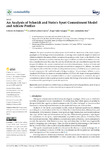An Analysis of Schmidt and Stein’s Sport Commitment Model and Athlete Profiles

Use este enlace para citar
http://hdl.handle.net/2183/30672
A non ser que se indique outra cousa, a licenza do ítem descríbese como Atribución 4.0 Internacional
Coleccións
- Investigación (CCDEF) [298]
Metadatos
Mostrar o rexistro completo do ítemTítulo
An Analysis of Schmidt and Stein’s Sport Commitment Model and Athlete ProfilesData
2022-02-02Cita bibliográfica
De Francisco, C.; Gómez-Guerra, C.; Vales-Vázquez, Á.; Arce, C. An Analysis of Schmidt and Stein’s Sport Commitment Model and Athlete Profiles. Sustainability 2022, 14, 1740. https://doi.org/10.3390/su14031740
Resumo
[Abstract] The sport commitment model proposed by Schmidt and Stein is one of the most complete paradigms on the etiology of burnout syndrome. According to this model, the degree of burnout of athletes is related to the nature of their commitment to sporting activity. Based on the Benefits, Costs, Satisfaction, Alternatives, and Investments, three types of athletes are defined: (1) athletes who are fully committed because they enjoy the activity; (2) athletes who are committed because they feel trapped; (3) athletes who are not committed and are at risk of abandonment. Analysis of cluster and analysis of variance were performed using data collected from a sample of 357 athletes. The results were aligned with the Schmidt and Stein model predictions in terms of athlete type and partial scores for each component of the model, although with slight variations. The percentage of athletes correctly classified is 99.35% for the cluster of committed athletes; 97.35% for the cluster of entrapped athletes; 96.63% for the cluster of non-committed athletes at risk of abandonment. In conclusion, the sport commitment model provides a useful approach to explain the etiology of burnout in athletes, helping to understand the psychological keys to the syndrome.
Palabras chave
Sport commitment
Athlete burnout
Entrapment
Social exchange theory
Sport Dropout
Love-commitment theory
Investment model
Sport enjoyment
Satisfaction
Compromiso deportivo
Esgotamento do deportista
Atrapamento
Teoría do intercambio social
Abandono do deporte
Teoría do amor-compromiso
Modelo de investimento
Satisfacción deportiva
Agotamiento del deportista
Atrapamiento
Teoría del intercambio social
Abandono del deporte
Teoría del amor-compromiso
Modelo de inversión
Athlete burnout
Entrapment
Social exchange theory
Sport Dropout
Love-commitment theory
Investment model
Sport enjoyment
Satisfaction
Compromiso deportivo
Esgotamento do deportista
Atrapamento
Teoría do intercambio social
Abandono do deporte
Teoría do amor-compromiso
Modelo de investimento
Satisfacción deportiva
Agotamiento del deportista
Atrapamiento
Teoría del intercambio social
Abandono del deporte
Teoría del amor-compromiso
Modelo de inversión
Versión do editor
Dereitos
Atribución 4.0 Internacional
ISSN
2071-1050






